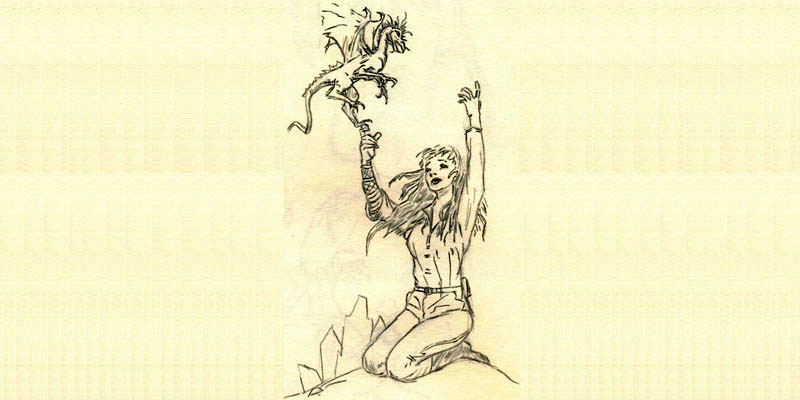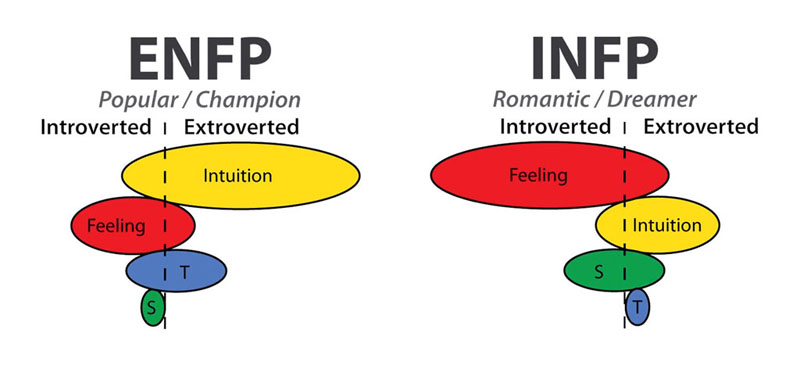In my previous post, I indicated that the MBTI personality types were misleading and that Carl Jung’s cognitive functions were the solution. After reading “Gifts Differing” by Isabel Briggs Myers, who created the MBTI instrument with her mother Katherine Cook Briggs, I realized that I had misunderstood. The cognitive functions theory that I learned is based upon Dr. Carl Jung’s book, “Psychological Types”, but includes enhancements and clarifications from Mrs. Myers and Mrs. Briggs. The MBTI instrument is the result of making Carl Jung’s cognitive functions theory relevant to and easy to understand by the average person. Isabel Briggs Myers and Katherine Cook Briggs built upon Carl Jung’s cognitive functions theory with two major contributions.
Crouching Extravert, Hidden Introvert
First, for the average person, the dominant and auxiliary (secondary) cognitive functions must work together to balance each other out. Dr. Carl Jung concentrated on unbalanced personalities (especially introverts) where the dominant function was supreme and was not in balance with the auxiliary. He did not explore balanced types and only mentioned the auxiliary function in a few references without great detail. Myers and Briggs fleshed out the role of the auxiliary function.
To be balanced, if the dominant function is a judging function (Thinking or Feeling), then the auxiliary must be a perceiving function (Sensing or iNtuition) and vice versa. If the dominant function is extraverted, then the auxiliary must be introverted and vice versa. In effect, the auxiliary function is opposite to and balances the dominant function between judging and perceiving and between extroversion and introversion.
Second, the most visible personality trait seen by the outside world is the first extraverted function, which is used to interact with the exterior world. For extraverts, this is the dominant function. For introverts, this is the auxiliary function (because the dominant is introverted). Thus, introverts have a dominant function which is hidden, and people interact mainly with the introvert’s auxiliary function. This leads to confusion because someone who is viewed as perceiving by others may be an introverted judging dominant type. Likewise, someone who appears very judging to others may be an introverted perceiving dominant type.
When thinking of balanced types, each type has an inward-facing and an outward facing function, which could be any of the four perceiving and judging functions. For example, an INFP has an inward-facing introverted dominant Feeling function and an outward-facing extraverted auxiliary iNtuiton function. An ESTJ has an outward-facing extraverted dominant Thinking function and an inward-facing introverted auxiliary Sensing function. When one interacts with the INFP, one sees visible indications of the outward-facing iNtuition function (auxiliary) in how the INFP gets along with everyone. When one interacts with the ESTJ, one sees visible indications of the outward-facing Thinking function (dominant) in how the ESTJ takes time to think and talk through decisions.
Note: One can see how the MBTI instrument and cognitive functions are tied together by how the MBTI can be mapped to the cognitive functions. As we explored in the previous post, the cognitive functions theory does not treat the first E/I (Extroversion/Introversion) and last J/P (Judging/Perceiving) MBTI preferences as standalone functions. Instead, the E/I preference indicates the attitude (E/I orientation) of the dominant function and thus, the attitudes of the remaining functions. The J/P preference indicates the extraverted perceiving or judging function used to deal with the external world. For dominant extraverts (E), this is the dominant function. For dominant introverts (I), this is the auxiliary function.
When identifying personality types, the goal is to determine the dominant function. Unfortunately, this is difficult when dealing with introverts. The most visible function is outward-facing and can be dominant (for extraverted dominant types) or auxiliary (for introverted dominant types). For example, an ISTP has a visible external-facing Sensing function which is the ISTP’s auxiliary function. But for an ESTP which also has a visible external-facing Sensing function, it is the ESTP’s dominant function. To determine which is which, one must either spend a lot of time with the person or much faster, one could just ask the person questions to learn what their dominant function is. This is why the MBTI creators describe the instrument as a self-reporting tool.
What Type Am I Again?
Update: I may sound certain that I am an ENFP below, but I am not 100% sure. I am continually swinging between INFP and ENFP. When I wrote this post, I believed I was more on the ENFP side. In this update, I believe I am more INFP. Unfortunately, ambivalence may come with the MBTI territory.
Even as a self-reporting tool, it may be difficult for a person to accurately MBTI type himself. Case in point, I’ve recently realized that I am an ENFP, not an INFP. As I understood more about MBTI and cognitive functions, I’ve refined my type. (DaveSuperPowers has a video on this ENFP vs INFP confusion.) If we compare the cognitive functions for ENFP and INFP (see below), we see that the functions and attitudes are the same, but the order is different. For both types, I would use the same extraverted iNtuition function to interact with the external world, whether I was an extrovert or an introvert. Someone observing me would have a difficult time deciding which E/I type I was. Because ENFP is the most introverted of the extraverts, I had a hard time myself figuring out which side of the E/I divide I belonged to. When I’m alone, after a while, I want to be with people. When I’m with people, after a while, I want to be alone.
I think the view of the E/I preference as being how one gets energy is confusing. The theory is that an extravert would be energized by being with and interacting with people and an introvert would be energized by being alone. I don’t experience this at all. Instead, I believe that energy expenditure is a better indicator. Introverts are drained of their energy faster than normal when forced to interact with people (to extravert). An extreme introvert would reach energy exhaustion quickly. Likewise, extraverts are drained of their energy faster than normal when forced to be alone (to be introspective). In both cases, I believe that the introverts and extraverts are forced to use their auxiliary functions, which use up more energy than using their dominant functions would. Even as an extravert, when I’m with people who are boring and who don’t want to engage (in conversation or activity) with me, I do expend more energy to compensate and thus become exhausted faster.
Having said the above, there are scenarios where I feel that I’m not expending energy or even that I am gaining energy, but they are independent of the E/I preference. Zero energy expenditure can seem to occur when I am deeply concentrating on a task (I am in the flow) and hours pass without me getting tired. And I seem to gain energy when I am participating in an activity or interacting with people that I am very passionate about. I gain energy whether I’m doing an interesting solitary activity (Introversion) or partying with a bunch of closed friends (Extraversion).
The trick to identifying my type is what most books recommend to do, which is to recall how I was like when I was younger, preferably in high school and college. I believe that high school helps to solidify our dominant preferences which we then exhibit clearly in college. After college, when we join the workforce, we are forced to strengthen our auxiliary and lesser functions (even our shadow functions) to cope with work demands, coworkers, and bosses. As an ENFP, I have to thank my work experience for my strong ability to focus on the details (shadow Sensing function) and to bring projects to completion (shadow Judging function). With life experience and age, all our cognitive functions mature and we become very balanced. If I take an MBTI test and answer the questions based upon who I am now, the test would not provide a strong match to any particular MBTI type. I have to force myself to answer based upon who I was when I was young.
The second trick is to read self descriptions from other people by MBTI type to see which ones I most identify with. For this to work, the source of the self descriptions must be accurate. The source that I recommend is the book titled “The 16 Personality Types: Descriptions for Self-Discovery” by Linda V Berens. After reading the self descriptions for INFP and ENFP, I was surprised to find that I currently identified very strongly with ENFP and very weakly with INFP. To double-check, I recalled how I was in high school (where I was active in many clubs, often as an officer) and college (where I organized parties and dinners for other students and alumni). In the end, ENFP with its dominant extraverted iNtuition function seemed a more fitting match for me.
I feel that after a long journey, I have finally identified my MBTI type. However, at the same time, I realized that my MBTI type may no longer strongly identify the current me. My INTJ friend tells me that I am a disturbance to his system of identifying MBTI types because I behave in contradictory ways. I took that as a compliment and think that he truly enjoys trying to upgrade his system to account for my behavior. Dr. Carl Jung and Mrs. Isabel Briggs Myers briefly mentioned that eventually, with age and maturity, an individual may transcend their type. I don’t know what that would be like, but as an ENFP, I find it very intriguing. I can’t wait to see what happens next.
Check out my continuing post on this topic, Judging vs Perceiving Dominant Types.



[…] Thinking function (dominant) in how the ESTJ takes time to think and talk through decisions. Do The Void! » Blog Archive MBTI: Not Misleading, Just Misunderstood – Do The Void! So according to what the author of the blog wrote, introverts would show their first extroverted […]